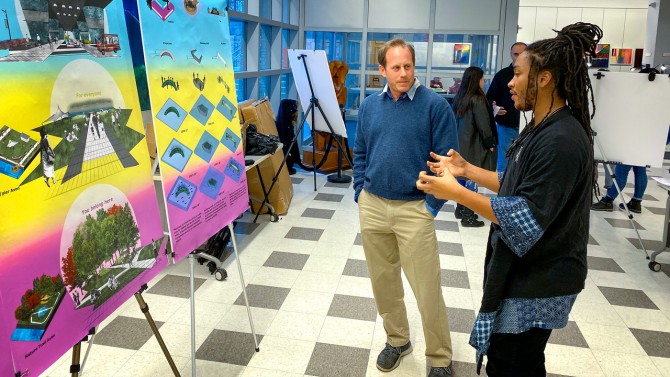
In this artistic rendering by Lingyi Xu, MLA ’20, she reimagines the space under her proposed elevated rail near the Ossining waterfront. It provides a shelter for festivals and a farmers’ market, and protects transportation systems and residential areas from a rising Hudson River.
Students sketch Ossining’s budding waterfront ideas
By Blaine Friedlander
The banks of the Hudson River shore at Ossining, New York, may seem tranquil now, but the Westchester County town – and other villages along the river – face a watery future: Due to projected climate change effects, the Hudson is rising.
Cornell graduate students studying landscape architecture examined Ossining last fall, and in mid-December presented the town and village with ideas for climate-change adaptation. The student projects included marrying the built environment with marshy wetlands, plugging in more recreation, and working in tandem with natural and environmental systems.
“Students are a central part of this work,” said Josh Cerra, associate professor in landscape architecture, who teaches the climate-adaptive design studio course. “The students’ design explorations and research move ideas forward for communities.”
In a report released two years ago, the New York State Department of Environmental Conservation (NYS-DEC) projected that the lower Hudson River could rise 2-10 inches by the late 2020s. That projection soars to 8-30 inches in the 2050s, and to as many as 58 inches – nearly five feet – by the 2080s. The water may rise to 75 inches higher, from the current base, at the turn of the next century.
Students taking the class have offered ideas for other Hudson River towns since 2015, when the climate-adaptive design studio started.
“Waterfronts are places of human desire,” said Mark Schrader MLA ‘21. “The waterfront has only a sliver of land accessible to the public, but to get there you have to cross above the [Metro North] railroad tracks and thread through automobile congestion. There are number of competing priorities.”
Schrader’s proposed idea connects the town to the waterfront, so that it serves as an economic hub – suggesting investments into artistic and cultural amenities and critical infrastructure. His design reflects facilitating social and environmental equity by establishing a contiguous, publicly accessible, floodable greenway, and facilitating marsh migration by manipulating the near-shore landform.
Schrader worked with Iratxe López de Subijana, an undergraduate, engineering Cornell exchange student from the Universidad de Cantabria, Spain, who provided help to understand the area’s watershed and flood control measures.
Subijana and other student engineers from a class with Todd Walter, professor of biological and environmental engineering, helped with the other Ossining projects.
Lingyi Xu, MLA ‘20, created four layers to the riverfront to blend the concrete world with nature. On the waterfront, she suggested a buffer of preserved wetlands, watched over by restaurants and shops uphill. She designed a green corridor for walking, biking and recreation, followed by a layer of transportation.
Xu proposed elevating the railroad tracks 16 feet, creating a usable, flexible space underneath. “Rail elevation creates a shelter for outdoor activities such as food festivals, a farmers market and music festivals,” said Xu, who worked with civil engineering student Alex Dzieman ‘20 to research Ossining’s drainage system and the best ways to elevate the rail along the waterfront.
The Resilient Waterfronts team at the Hudson River Estuary Program, part of the NYS DEC and Cornell’s New York State Water Resources Institute, helps waterfront communities along the river develop a vision, adapt to sea-level rise and flooding over the long term.
While no formal plans exist for Ossining’s future waterfront, the residents are discussing a collective action. The city of Kingston, New York, and the village of Piermont, New York – where Cerra’s previous classes presented their visions in earlier years – have begun working with the NYS-DEC and professional design firms in mid-2019 to develop projects – inspired in part by the students’ ideas – to boost waterfront resiliency.
Said Xu: “This class was different from others. I had the chance to talk with stakeholders and get to know what the residents really wanted.”
Cerra and Walter are fellows with the Cornell Atkinson Center for Sustainability. Student travel funds to Ossining for research and presentations were provided by Water Resources Institute and Cornell’s Office of Engagement Initiatives.
Media Contact
Get Cornell news delivered right to your inbox.
Subscribe


